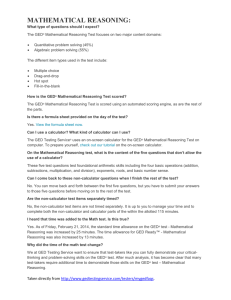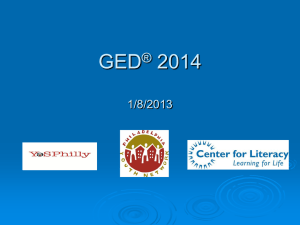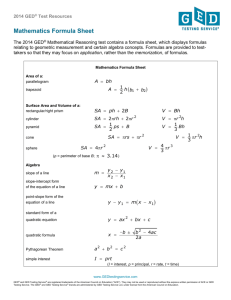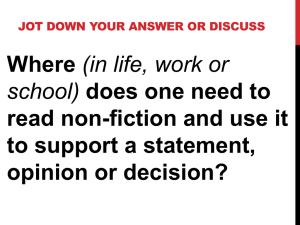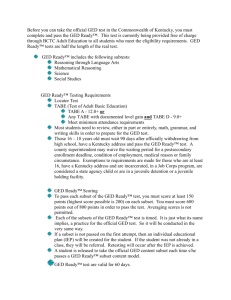learning disablity General Educational Development (RFC)
advertisement
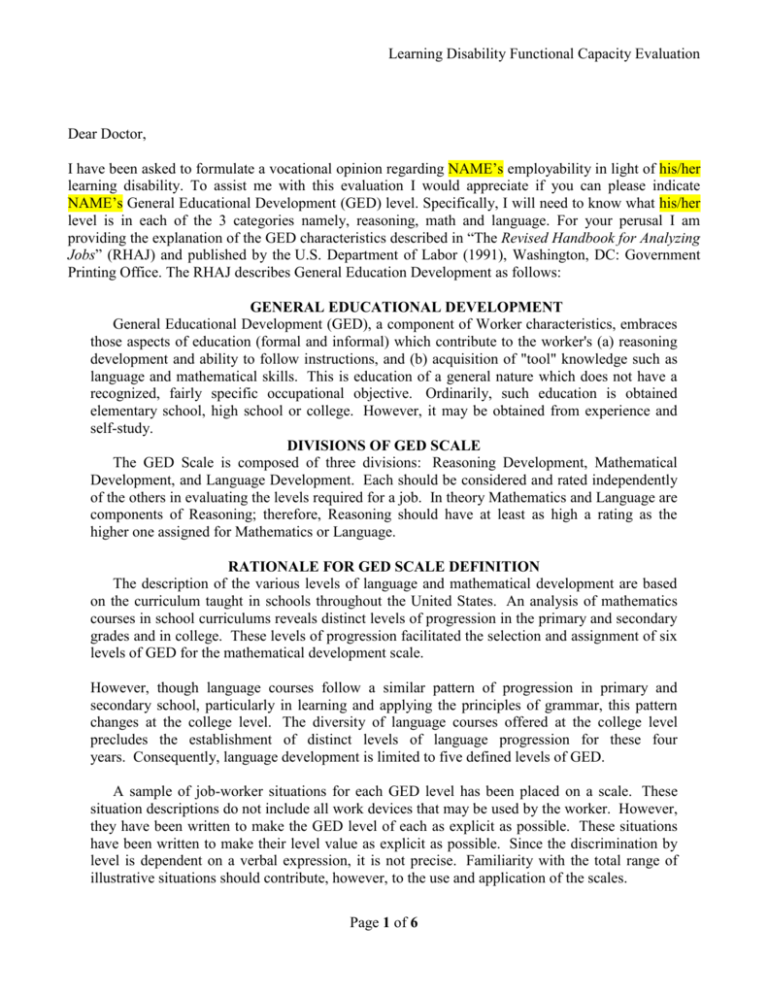
Learning Disability Functional Capacity Evaluation Dear Doctor, I have been asked to formulate a vocational opinion regarding NAME’s employability in light of his/her learning disability. To assist me with this evaluation I would appreciate if you can please indicate NAME’s General Educational Development (GED) level. Specifically, I will need to know what his/her level is in each of the 3 categories namely, reasoning, math and language. For your perusal I am providing the explanation of the GED characteristics described in “The Revised Handbook for Analyzing Jobs” (RHAJ) and published by the U.S. Department of Labor (1991), Washington, DC: Government Printing Office. The RHAJ describes General Education Development as follows: GENERAL EDUCATIONAL DEVELOPMENT General Educational Development (GED), a component of Worker characteristics, embraces those aspects of education (formal and informal) which contribute to the worker's (a) reasoning development and ability to follow instructions, and (b) acquisition of "tool" knowledge such as language and mathematical skills. This is education of a general nature which does not have a recognized, fairly specific occupational objective. Ordinarily, such education is obtained elementary school, high school or college. However, it may be obtained from experience and self-study. DIVISIONS OF GED SCALE The GED Scale is composed of three divisions: Reasoning Development, Mathematical Development, and Language Development. Each should be considered and rated independently of the others in evaluating the levels required for a job. In theory Mathematics and Language are components of Reasoning; therefore, Reasoning should have at least as high a rating as the higher one assigned for Mathematics or Language. RATIONALE FOR GED SCALE DEFINITION The description of the various levels of language and mathematical development are based on the curriculum taught in schools throughout the United States. An analysis of mathematics courses in school curriculums reveals distinct levels of progression in the primary and secondary grades and in college. These levels of progression facilitated the selection and assignment of six levels of GED for the mathematical development scale. However, though language courses follow a similar pattern of progression in primary and secondary school, particularly in learning and applying the principles of grammar, this pattern changes at the college level. The diversity of language courses offered at the college level precludes the establishment of distinct levels of language progression for these four years. Consequently, language development is limited to five defined levels of GED. A sample of job-worker situations for each GED level has been placed on a scale. These situation descriptions do not include all work devices that may be used by the worker. However, they have been written to make the GED level of each as explicit as possible. These situations have been written to make their level value as explicit as possible. Since the discrimination by level is dependent on a verbal expression, it is not precise. Familiarity with the total range of illustrative situations should contribute, however, to the use and application of the scales. Page 1 of 6 Learning Disability Functional Capacity Evaluation On the following page I am providing you with the 3 categories of General Education Development (GED) characteristics developed by the Department of Labor. Specifically, I would like to know what his/her GED level is in each of the 3 categories; reasoning, math and language. It is my hope that you can assist me in clarifying this matter. I appreciate your attention to this matter, Page 2 of 6 Learning Disability Functional Capacity Evaluation LEARNING DISABLITY GENERAL EDUCATIONAL DEVELOPMENT (RFC) Name: Claim #: Date of Injury: Please Print Name of Medical Evaluator: Medical Specialty: What is the first date patient’s impairment(s) became “severe” meaning that his/her impairment(s) caused interference ADL’s or ability to work? When did you begin treating the patient? How frequently do you see your patient? Date: Date: Date: Please indicate the closest GED level in each of the 3 categories; reasoning, math and language that apply to your patient. Scale of General Education Development (GED) LEVEL REASONING DEVELOPMENT MATHEMATICAL DEVELOPMENT LANGUAGE DEVELOPMENT 6 Apply principles of logical or scientific thinking to a wide range of intellectual and practical problems. Deal with nonverbal symbolism (formulas, scientific equations, graphs, musical notes, etc.) in its most difficult phases. Deal with a variety of abstract and concrete variables. Apprehend the most abstruse classes of concepts. Advanced calculus: Same as Level 5. Work with limits, continuity, real number systems, mean value theorems, and implicit function theorems. Modern Algebra: Apply fundamental concepts of theories of groups, rings and fields. Work with differential equations, linear algebra, infinite series, advanced operations methods, and functions of real and complex variables. Statistics: Work with mathematical statistics, mathematical probability and applications, experimental design, statistical inference, and econometrics. 5 Apply principles of logical or scientific thinking to define problems, collect data, establish facts, and draw valid conclusions. Interpret an extensive variety of technical instructions in Algebra: Work with exponents and logarithms, linear equations, quadratic equations, mathematical induction and binomia theorem, and permutations. Page 3 of 6 Reading: Read literature, book and play reviews, scientific and technical journals, abstracts, financial reports, and legal documents. Writing: Learning Disability Functional Capacity Evaluation mathematical or diagrammatic form. Deal with several abstract and concrete variables. Calculus Apply concepts of analytic geometry, differentiations and integration of algebraic functions with applications. Statistics: Apply mathematical operations to frequency distributions, reliability and validity of tests, normal curve, analysis of variance, correlations techniques, chi-square application and sampling theory, and factor analysis. Write novels, plays, editorials, journals speeches, manuals, critiques, poetry and songs. Speaking; Conversant in the theory, principles, and methods of effective and persuasive speaking, voice and diction, phonetics, and discussion and debate. 4 Apply principles of rational systems to solve practical problems and deal with a variety of concrete variables in situations where only limited standardization exits. Interpret a variety of instructions furnished in written, oral, diagrammatic, or schedule form. (Examples of rational systems include: bookkeeping, internal combustion engines, electric wiring systems, house building, farm management, and navigation.) Algebra: Deal with systems of real number; linear, quadratic, rational, exponential, logarithmic, angle and circular functions, and inverse functions, and inverse functions; related algebraic solution of equations and inequalities; limits and continuity; and probability and statistical inference. Geometry: Deductive axiomatic geometry, plane and sold, and rectangular coordinates. Shop Math: Practical application of fractions, percentages, ratio and proportion, measurement, logarithms, practical algebra, geometric construction, and essentials of trigonometry. Reading: Read novels, poems, newspapers, periodicals, journals, manuals, dictionaries, thesauruses, and encyclopedias. Writing: Prepare business letters, expositions, summaries, and reports, using prescribed format and conforming to all rules of punctuation, grammar, diction and style. Speaking; Participate in panel discussions, dramatizations, and debates. Speak extemporaneously on a variety of subjects. 3 Apply commonsense understanding to carry out instructions furnished in written, oral, or diagrammatic form. Deal with problems involving several concrete variables in or from standardized situations. Compute discount, interest, profit and loss; commission, markup, and selling price; ratio and proportion; and percentage. Calculate surface, volumes, weights, and measures. Algebra: Calculate variables and formulas; monomials and polynomials; ratio and proportion variables; and square roots and radicals. Geometry: Calculate plane and solid figures, circumference, area, and volume. Understands kinds of Reading: Read a variety of novel, magazines, atlases, and encyclopedias. Read safety rules, instruction in the use and maintenance of shop tools and equipment, and methods and procedures in mechanical drawing and layout work. Writing: Write reports and essays with proper format, punctuation, spelling, and grammar, using all parts of speech. Speaking; Speak before an audience with poise, voice control, and confidence, using Page 4 of 6 Learning Disability Functional Capacity Evaluation angles and properties of pairs and angles. correct English and well-modulated voice. 2 Apply commonsense understanding to carry out detailed but uninvolved written or oral instructions. Deal with problems involving a few concrete variables in or from standardized situations. Add, subtract, multiply, and divide all units of measure. Perform the four operations with like common and decimal fractions. Compute ratio, rate and percent. Draw and interpret bar graphs. Perform arithmetic operations involving all American monetary units. Reading: Passive vocabulary of 5,000 - 6,000 words. Read at rate of 190-215 words per minute. Read adventure stories and comic books, looking up unfamiliar words in dictionary for meaning, spelling and pronunciation. Read instructions for assembling model cars and airplanes. Writing: Write compound and complex sentences, using cursive style, proper end punctuation, and employing adjectives and adverbs. Speaking: Speak simple sentences, using normal word order, and present and past tenses. 1 Apply commonsense understanding to carry our simple one or two-step instructions. Deal with standardized situations with occasional or no variables in or from these situations encountered on the job. Add and subtract two-digit numbers. Multiply and divide 10's and 100's by 2, 3, 4, 5. Perform the four basic arithmetic operations with coins as part of a dollar. Perform operations with units such as cup, pint, and quart; inch, foot and yard; and ounce and pound. Reading: Recognize meaning of 2,500 (two- or three-syllable) words. Read at rate of 95-120 words per minute. Compare similarities and differences between words and between series of numbers. Writing: Print simple sentences containing subject, verb, and object and series of numbers, names and addresses. Speaking: Speak simple sentences, using normal word order, and present and past tenses. *If claimant’s math abilities and/or inability to speak, write, or converse in English are less than 1, please assume 0 capabilities. GED SCORE: Reasoning: 2 3 4 5 1 0 0 6 1 Math: 2 3 4 5 6 1 Language: 2 3 4 5 6 Page 5 of 6 Learning Disability Functional Capacity Evaluation I declare under penalty of perjury that the information contained in this report and its attachments, if any, is true and correct to the best of my knowledge and belief, except as to information that I have indicated I received from others. As to that information, I declare under penalty of perjury that the report accurately describes the information provided to me and except as noted herein, that I believe it to be true. I also declare under the perjury that this physician has no violated section 139.3 of the Labor Code. My opinions are expressed to a degree of medical probability, unless otherwise stated. Signature of Physician ____________________________________ Comments: Page 6 of 6 Date
